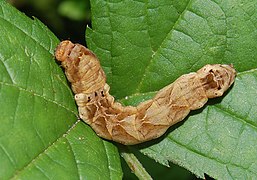Rose owl
| Rose owl | ||||||||||||
|---|---|---|---|---|---|---|---|---|---|---|---|---|

Rose owl ( Thyatira batis ) |
||||||||||||
| Systematics | ||||||||||||
|
||||||||||||
| Scientific name | ||||||||||||
| Thyatira batis | ||||||||||||
| ( Linnaeus , 1758) |
The rose owl ( Thyatira batis ) is a butterfly from the family of owl moths and sickle-winged birds (Drepanidae). Despite its German name, it does not belong to the group of owl butterflies (Noctuidae), but is predominantly part of its own subfamily, which is poor in our species, owl moth.
features
The moths reach a wingspan of 32 to 38 millimeters. They have dark, gray-brown or gray fore wings with fine black transverse lines. The five oval, whitish to pinkish spots that are brown in the middle are striking. The hind wings are light gray, but become darker towards the edge.
The caterpillars are about 35 millimeters long. They are red-brown to lilac-brown and have bumps on the back on the 2nd, 5th, 9th and 11th segments. There is also a light, triangular drawing on the back. Young caterpillars are gray-brown with a large white spot on the top of the front segments.
- Color morphs of the caterpillar
Occurrence
The animals are common in North Africa , Central Europe and Asia to Japan and almost everywhere up to approx. 1,500 m above sea level . They live in deciduous and coniferous forests and on their edges with stocks of their forage plants, but also on wet meadows with bushes and in gardens.
Way of life
The nocturnal moths usually fly in two overlapping generations from May to August each year. You like to fly to artificial light sources.
Flight and caterpillar times
The moths fly in two generations from late May to early July and from early to late August. The caterpillars from the eggs of the first generation are found from late August to mid-September, those of the second from July to August the following year.
Food of the caterpillars
The caterpillars eat the leaves of blackberries ( Rubus fruticosus ) and raspberries ( Rubus idaeus ), sometimes also of currants ( Ribes ).
development
The females lay their eggs individually on the leaf margins. The caterpillars are also nocturnal, but the young caterpillars in particular sit motionless on the leaves of their forage plants during the day. Through their bent-posture, less by their color, they see bird droppings similar ( Vogelkotmimese ). The adult caterpillars usually hide, but sometimes sit in the same position as the young on the leaves. They pupate between spun leaves. The second generation only pupates in October and hibernates before they hatch in the next spring. The pupae have a length of 12-13 mm. In one case, pupation lasted from June 6th to June 19th, a total of 13 days.
swell
literature
- Günter Ebert (Ed.): The Butterflies of Baden-Württemberg Volume 4, Moths II (Bombycidae, Endromidae, Lemoniidae, Saturniidae, Sphingidae, Drepanidae, Notodontidae, Dilobidae, Lymantriidae, Ctenuchidae, Nolidae). Ulmer Verlag Stuttgart 1994. ISBN 3-800-13474-8
- Heiko Bellmann : The new Kosmos butterfly guide. Butterflies, caterpillars and forage plants. Franckh-Kosmos, Stuttgart 2003, ISBN 3-440-09330-1 .
- Hans-Josef Weidemann, Jochen Köhler: Moths. Weirdos and hawkers. Naturbuch-Verlag, Augsburg 1996, ISBN 3-89440-128-1 .
Individual evidence
- ↑ Manfred Koch : We identify butterflies. Volume 2: Bears, Spinners, Swarmers and Drills in Germany. 2nd, expanded edition. Neumann, Radebeul / Berlin 1964, DNB 452481929 , pp. 120f.
Web links
- Lepiforum e. V. Taxonomy and Photos
- www.schmetterling-raupe.de
- www.insektenbox.de
- Moths and Butterflies of Europe and North Africa (English)
- Ian Kimber Guide to the moths of Great Britain and Ireland (English)
- Thyatira batis at Fauna Europaea





